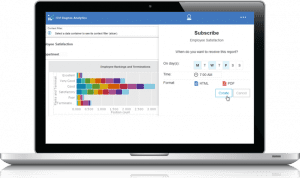With a much needed overhaul of the user interface and a complete re-focus on usability, this release has everyone in the business of analytics talking about it, even customers who once told me they would never consider it as an option. Here’s why:
1. Self Service Analytics
Every BI vendor big and small claim to be able to provide self-service analytics. So how does this differ from any other offering? Enterprise BI solutions which are maintained mostly within IT or if you are ahead of the game – a BICC (BI Competency Center) – are often viewed by business users as being bottlenecks to analysis. That is, users can’t get the information quick enough to make the decisions they need at the right time. This has led to a flood of start-up companies and niche vendors like Tableau who offer their business customers the ability to go rogue and purchase a tool (on the web using their credit card) which allows them to be fully autonomous with their analysis. Bringing back the age old problem that BI vendors and IT teams were trying to solve in the 90’s and 00’s of multiple versions of the truth.
Cognos Analytics aims to address the need for autonomous analytics for business users but still within an enterprise environment by allowing business users the ability to upload and analyse data, even join it to corporate data maintained by IT. Analysis is easily moved from ad-hoc to enterprise-wide reporting without the need to rebuild it in another “enterprise BI” solution to be distributed throughout the organisation.
2. Intuitive Web-Based Interface
A complete overhaul of the user interface offers an easy-to-use analytics environment allowing you to do “data discovery” and “traditional BI” in the one place. Many of my customers have implemented both these types of solutions and many are looking to replace one or both with a single solution that can do it all. The best news for IT – everything is done over the web! No desktop applications to maintain, no report reader applications to maintain, no additional browser plugins to maintain (not that Cognos ever had any anyway).
3. Dashboarding
The dashboarding capability of the Cognos solution has also had a complete overhaul and for the better. The ability to drag and drop data onto the screen and see the visualisation change to suit the analysis, and simply creating your own dashboard on the fly gives you faster access to information and thereby quicker time to value. Not only is it easy to use, it is also very good-looking, pleasing the VP’s of the world who want a pretty dashboard (oh yes, I have seen it time and time again where an organisation introduces a new BI tool because a VP saw a sexy dashboard at a conference and was sold on it immediately).
4. Mobile
The mobile app for Cognos BI has always been a winner with its high level of security, sexy dashboards and the ability to have the same reports on the desktop and mobile device without having to rewrite them (in some other vendors solution the reports have to be re-authored to be consumed over a mobile device). The biggest change here is now you can now author your reports on a mobile device. For anyone who is constantly on the road like me, this is a great thing.
5. Easy to Implement
Nothing new to existing customers, but for those who aren’t as familiar with the Cognos solution, this tool is the fastest tool to implement at an enterprise level on the BI market today. The solution can be deployed over the cloud (described below) or on-premises. The solution is a multi-tiered architecture, highly scalable and highly configurable. This has been the case with the product since day one. A colleague and I implemented the solution many years ago in its first release to thousands of users at a large UK organisation within 2 weeks – a tight timeline with massive success. The solution only grew from there as demand for information escalated within the organisation and we quickly moved the environment over to a multi-server load-balanced environment – about 10-12 servers, all set up within a couple of days.
6. Cloud
While we are on the subject, Cognos Analytics is now available as a service on the cloud so it is even easier to get up and running. IBM has data centers all around the world. We all know the benefits of moving to the cloud – the biggest being lower IT and infrastructure costs – but also performance and scalability plays a big factor here too. You can connect to on-premises data sources, however if you are willing to move your data into the cloud (IBM offers dashDB in the cloud) then you will get optimal performance (your business users will love you).
7. Intent-Based Modeling and Search Capabilities
There is a lot of smart technology built into Cognos Analytics and it is all based on IBM Watson under the covers. Need to build a report on sales and product but not sure which tables to pull data from within the database? No problem, just create a new data model, type “product sales” and Watson will use the metadata from the table and column names to figure out what you might need to use. Think it looks right? Then it will go ahead and create the table joins for you (which you can modify if you need to) and create a model for you to start building dashboards and reports from. The search works much the same way… it searches the meta data within reports, including comment and headings etc to return to you as search results so you no longer need to navigate through thousands of reports looking for the right report.
8. You can try it for FREE!
http://www.budgetingsolutions.co.uk/about-us/contact-us/request-demo/


Share this Article: [DISPLAY_ULTIMATE_SOCIAL_ICONS]